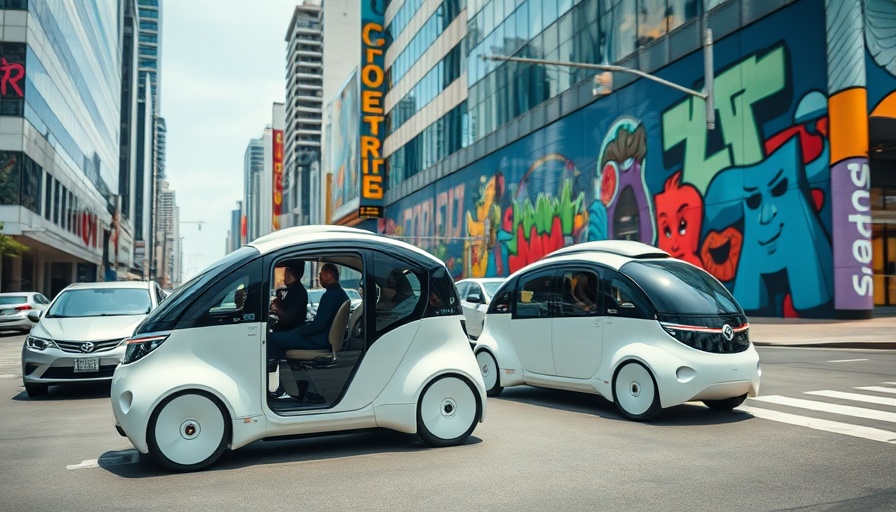
Waymo vs. Tesla: Who Will Dominate Austin's Robotaxi Landscape?
In a burgeoning competition for dominance in the autonomous vehicle space, Waymo and Tesla are making headlines in Austin, Texas. With Waymo recently announcing a dramatic expansion of its robotaxi service area from 37 to 90 square miles, it appears there is no holding back in this race. Tesla is still in the phase of limited rollout, offering robotaxis via invites only, creating a clear distinction in the approach to bringing self-driving technology to the public.
Understanding the Robotaxi Service Expansion
Waymo's service area expansion comes at an interesting time, just days after Tesla displayed its newly shaped geofence—dubbed “phallic-shaped”—in Austin. This geographic competition highlights how the two companies aim to not only grow their customer base but also outpace each other in market presence. Although Waymo's expanded coverage includes numerous neighborhoods, it comes with notable restrictions. Passengers in Austin are currently limited to rides offered through the Uber app, which sometimes defaults to a human driver when navigating highways like the 35 or MoPac Expressway, areas largely under Waymo's autonomous operation radar.
Challenges and Limitations: What Customers Should Expect
The expansion doesn’t guarantee an immediate increase in ride accessibility for users. Waymo’s system necessitates a seamless pairing through Uber, irrespective of user preferences. This means that for some routes, automated rides may not be an option. As noted in a recent test by Business Insider, even when hoping for a robotaxi, customers were frequently matched with a human driver on high-demand routes. Furthermore, while Waymo has succeeded in leveraging its technology in urban settings, it remains unable to transport passengers along highways, thereby limiting the comfort and convenience that many riders expect from a robotaxi service.
Tesla's Current Standing and Future Prospects
As for Tesla, the threshold for entry remains strict. Currently, potential riders must await personal invitations to participate in the service, a factor that could cause frustration for many eager followers of the brand. Historically, CEO Elon Musk has expressed confidence in rapidly scaling operations, but many are left wondering when the service will officially open to the general population. The lack of clarity shrouding this timeline gives Waymo a potential advantage as it builds momentum in attracting users.
Market Trends in Autonomous Vehicle Services
This interpersonal competition among two tech giants reflects larger trends in the startup and entrepreneurship landscape, specifically concerning advancements and consumer adoption of autonomous vehicles. The ongoing rivalry may foster innovations in safety, convenience, and service efficiency that could ultimately benefit consumers. With increasing investments pouring into self-driving technology, the question remains: can either company pivot effectively to meet consumer demand as market conditions evolve in 2025 and beyond?
The Road Ahead: Predictions for Robotaxi Services
As we look ahead at the dynamics of the ongoing robotaxi race, some analysts predict that the introduction of more user-friendly features will be vital in luring customers. Both Waymo and Tesla will likely need to broaden the accessibility of their services to cement leadership in this space. This could include adjustments to their app interfaces, faster response times, or embracing partnerships with other rideshare platforms to enhance their service range. Regular updates indicating improvements and expansions may lead to an increasingly competitive atmosphere, motivating rapid advancements in technology.
Conclusion: The Future of Autonomous Services Lies Ahead
The battle for robotaxi supremacy is poised for engaging developments, not only in Austin but globally as cities begin to embrace self-service mobility systems. As consumers, it's essential to stay informed on these advancements, especially as they promise to redefine transportation options for businesses and individuals alike. The dawn of robotaxi services is an exciting prospect that carries the potential for improvements, not just in operational efficiencies but also in how we view mobility in urban landscapes.
To stay updated about developments in autonomous vehicle services and what it means for public transport, businesses, and economic growth, follow trends in the business news today. Keep an eye out for startup funding news and entrepreneurship trends as they unfold in the near future.
 Add Row
Add Row  Add
Add 




 Add Row
Add Row  Add
Add 

Write A Comment